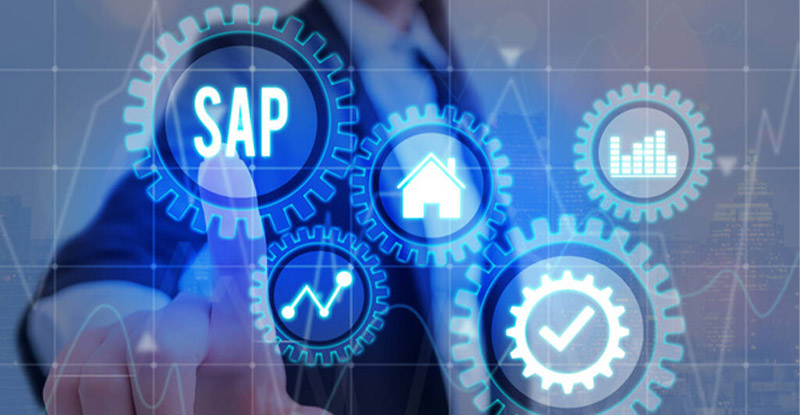SAP ERP vs. Other ERP Systems: Choosing the Right Solution for Your Business


Read the comparison of SAP ERP with other leading systems, unraveling industry focus, integration capabilities, and more. Make informed choices tailored to your business needs, backed by insights into scope, cost, and deployment options. Our guide empowers you to choose wisely, ensuring your business thrives in the competitive world of ERP solutions.
In the sprawling landscape of enterprise resource planning (ERP) systems, SAP reigns supreme like a towering mountain. But is it the best one of them? Before you plant your flag on its peak, it’s wise to explore the surrounding valleys, where a diverse ecosystem of ERP alternatives thrives. This article guides you through the terrain of SAP and its challengers, helping you discern the perfect fit for your business expedition.
Whether you’re a seasoned executive navigating the business software wilderness or a curious entrepreneur scaling your first peak, join us! We’ll dissect the strengths and weaknesses of SAP, compare it to popular rivals like Oracle, Acumatica, and Microsoft Dynamics 365, and equip you with the knowledge to conquer your ERP summit.
Unlock Efficiency with docAlpha and SAP Integration!
Streamline your business operations by seamlessly integrating Artsyl’s cutting-edge docAlpha with SAP ERP. Experience the power of automated document processing, advanced data capture, and enhanced workflow efficiency. Elevate your productivity and accuracy, ensuring your enterprise stays ahead in the dynamic business landscape.
Book a demo now
Choosing an ERP system feels like deciphering an ancient riddle: complex, shrouded in jargon, and ultimately, daunting. This checklist translates the cryptic language of ERP requirements into a clear roadmap for success. Ask the right questions, unveil the strengths and weaknesses of SAP and its rivals, and watch the fog of confusion lift. With each tick and each insightful answer, you’ll build a path towards the perfect ERP fit, propelling your business to new heights.

Contact Us for an in-depth
product tour!
Remember, the «best» ERP system is the one that perfectly aligns with your unique business needs and priorities. Use this checklist as a starting point for your research and ask plenty of questions to find the most optimal solution for your company’s success.
Supercharge SAP ERP with Artsyl’s Intelligent Invoicing!
Transform your SAP ERP experience with Artsyl’s intelligent invoice automation solutions. From invoice processing to order management, Artsyl enhances data accuracy and accelerates document workflows. Maximize the potential of your SAP ERP system – integrate with Artsyl for a leap forward in business excellence.
Book a demo now
Target Market
SAP ERP targets a broad spectrum, including large enterprises with complex business processes. Oracle ERP primarily focuses on large and global enterprises, offering solutions for intricate business structures.
Industry Focus
Scope of Functionality
Integration Capabilities
Cost
Deployment Options

Cloud vs. On-Premise
Licensing Model
User Interface
Ease of Use
Choosing between SAP ERP and Oracle ERP depends on various factors, including business size, industry focus, and specific functional requirements. Businesses should conduct a thorough assessment to determine which system aligns better with their unique needs and strategic objectives.

Experience a revolution in SAP ERP integration with Artsyl’s precision-driven solutions. Achieve seamless collaboration between Artsyl and SAP, optimizing your business processes for peak performance. Unleash the full potential of automated order data capture, workflow automation, and document processing.
Industry Focus
Scope of Functionality
Integration Capabilities
RELATED: The Complete Guide to SAP Enterprise Resource Planning (ERP)
Cost
Deployment Options

Cloud vs. On-Premise
Licensing Model
User Interface
Choosing between SAP ERP and Microsoft Dynamics 365 depends on the unique requirements of the business, including size, industry, and specific operational needs. Businesses should conduct a thorough assessment to determine which system aligns better with their strategic goals.
ArtsylPay + SAP ERP: Your Path to Intelligent Payment Processing!
Embark on a journey towards intelligent payment processing by integrating ArtsylPay with SAP ERP. Revolutionize the way you handle payments with Artsyl’s advanced automation. Witness unparalleled accuracy and efficiency as your enterprise embraces the future of business transfers.
Book a demo now
Industry Focus
Scope of Functionality
Integration Capabilities
Cost
Deployment Options

Cloud vs. On-Premise
Licensing Model
User Interface
Ease of Use
In the decision-making process for enterprise solutions, businesses consider these factors to determine the system that aligns with their specific operational requirements and strategic goals.
Optimize SAP ERP with Artsyl’s docAlpha!
Elevate your document processing, enhance data accuracy, and supercharge your workflow efficiency. docAlpha brings a new dimension to SAP integration, providing the tools you need for unparalleled success. Ready to redefine your enterprise efficiency? Integrate docAlpha with SAP ERP today and lead the game!
Book a demo now
Industry Focus
Scope of Functionality
Integration Capabilities
RELATED: Artsyl Cloud IPA Solutions for SAP Business One ERP
Cost
Deployment Options
Cloud vs. On-Premise
Licensing Model
Ease of Use
In evaluating SAP ERP and Epicor ERP, businesses consider these aspects to make informed decisions aligned with their industry focus, operational needs, and overarching business strategies.
It’s important to note that the choice between SAP ERP and other ERP systems depends on the specific needs, scale, and preferences of the business. Each system has its strengths and weaknesses, and the decision should align with the organization’s goals and requirements.
Seamless Integration, Unmatched Results
Witness the magic of seamless invoice processing integration as InvoiceAction meets SAP ERP to deliver unmatched results. Revolutionize your invoice management, boost accuracy, and streamline workflows effortlessly.
Book a demo now
While SAP ERP isn’t the only player in the game, it does stand out with some unique characteristics that appeal to a wide range of businesses. SAP offers a unified suite encompassing various functionalities like finance, inventory management, HR, customer relationship management (CRM), and supply chain management (SCM).
This one-stop-shop approach eliminates the need for integrating disparate systems, simplifying data management and streamlining processes.
RELATED: Intelligent Process Automation for SAP Business One ERP
SAP boasts deeply ingrained industry expertise, offering pre-configured solutions catered to specific sectors like manufacturing, healthcare, retail, and more. These tailored solutions eliminate the need for extensive customization and expedite implementation time.
With a massive global footprint and extensive support network, SAP empowers businesses to operate seamlessly across different countries and languages. Its high scalability also caters to organizations of all sizes, easily adapting to growth and evolving needs.
SAP invests heavily in cutting-edge technology, like artificial intelligence (AI) and machine learning (ML), embedded within its ERP solutions. This translates to automated processes, intelligent insights, and predictive capabilities for smarter decision-making.
SAP fosters a robust ecosystem of partners and a dedicated user community. This network offers access to expertise, support, and best practices, empowering users to get the most out of their SAP investment.
However, it’s important to consider the downsides of SAP ERP:
Ultimately, the «uniqueness» of SAP depends on your specific needs and priorities. If you value a comprehensive, industry-specific, and technologically advanced solution with global reach and strong support, then SAP might be a great fit. However, if budget or complexity are major concerns, consider exploring alternative ERP options that cater to your specific requirements.
Artsyl docAlpha intelligent process automation platform brings a new era of efficiency and precision to your SAP ERP experience. Ready to transform your enterprise? Integrate docAlpha seamlessly with SAP ERP and watch your business soar to new heights.
Book a demo now
The ascent through the world of ERP systems may seem daunting, but the panoramic view from the summit is worth every step. Armed with the insights gleaned from this blog, you’re now equipped to make an informed decision that scales your business to new heights. Remember, the «best» ERP isn’t a singular peak, but the one that perfectly aligns with your unique company landscape.
Don’t hesitate to explore further! Dig deeper into our comparison resources, consult with ERP experts, and embark on trial climbs with different systems. This journey is about finding the perfect fit, not a race to the top. Take your time, embrace the comparisons, and trust your internal compass.
SAP ERP is renowned for its versatility, catering to a wide range of industries with a comprehensive suite of modules. Its robust integration capabilities, deployment flexibility, and continuous efforts to enhance user experience set it apart.
While SAP ERP is adopted across diverse industries, some ERPs may have a more targeted industry focus. Specific ERPs, like Epicor, may tailor their solutions to industries such as manufacturing, distribution, or retail.
Yes, the scope of functionality varies. SAP ERP offers an extensive suite covering intricate business processes, whereas other ERPs may emphasize specific functionalities such as manufacturing, supply chain, or retail management.
Integration capabilities are crucial for seamless operations. SAP ERP and some other ERPs are recognized for robust integration, ensuring interoperability and continuity in data exchange with external systems.

SAP ERP may be associated with higher upfront costs, including licensing, implementation, and customization expenses. Other ERPs, like Acumatica, might offer a more budget-friendly approach with a subscription-based model.
SAP ERP provides flexibility with both on-premise and cloud deployment options. Other ERPs, such as Epicor, offer choices for on-premise, cloud, or hybrid deployments to accommodate diverse business preferences.
SAP ERP follows a traditional licensing model based on user licenses, modules, and customization choices. Other ERPs, like Acumatica, may utilize a subscription-based model, providing flexibility and scalability.
SAP ERP incorporates modern elements like SAP Fiori to enhance the user experience. Other ERPs, such as Epicor, also prioritize a user-friendly design for efficient navigation and usability.
Both SAP ERP and other ERPs focus on improving user experience. SAP ERP evolves to simplify operational workflows, while other ERPs prioritize a user-friendly design to ensure ease and efficiency.
Businesses should consider industry fit, functionality requirements, integration capabilities, cost considerations, deployment preferences, and user experience when choosing between SAP ERP and other ERPs. Each ERP has its strengths, and the decision should align with specific business needs and goals.